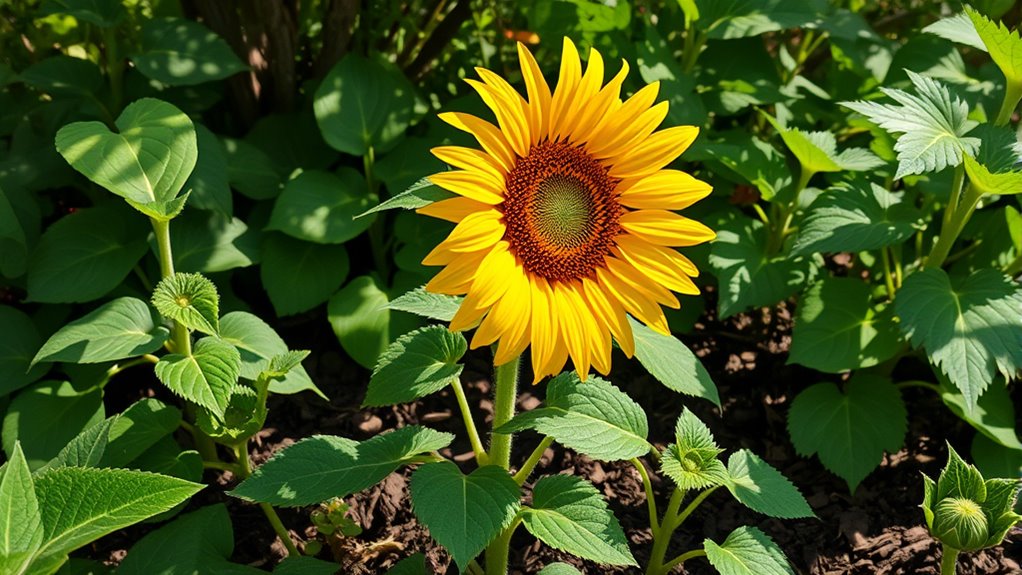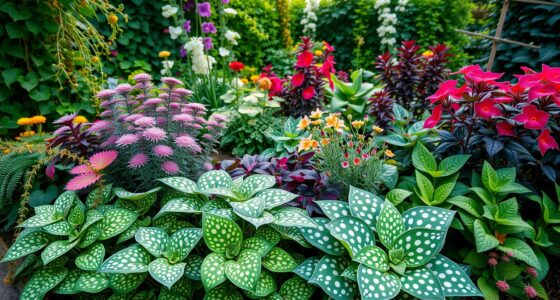To boost your sunflower garden, plant beneficial companions like marigolds, basil, nasturtiums, and cucumbers, which attract helpful insects and improve soil health. Avoid plants like potatoes, fennel, and mint that compete for resources or attract pests. Guarantee proper spacing and support, and choose plants suited to your season for ideal growth. Keep exploring these tips to create a vibrant, thriving sunflower ecosystem—there’s more to discover for a healthier garden.
Key Takeaways
- Plant sunflowers near herbs like basil and marigolds to attract beneficial insects and repel pests.
- Avoid growing potatoes, fennel, and mint close to sunflowers due to root competition and pest attraction.
- Space sunflowers adequately and stake tall varieties for stability and optimal growth.
- Use companion plants like cucumbers and beans that do not compete for nutrients and improve soil health.
- Ensure full sun, good air circulation, and seasonal timing to maximize sunflower growth and ecosystem benefits.
Ideal Plants to Grow Near Sunflowers
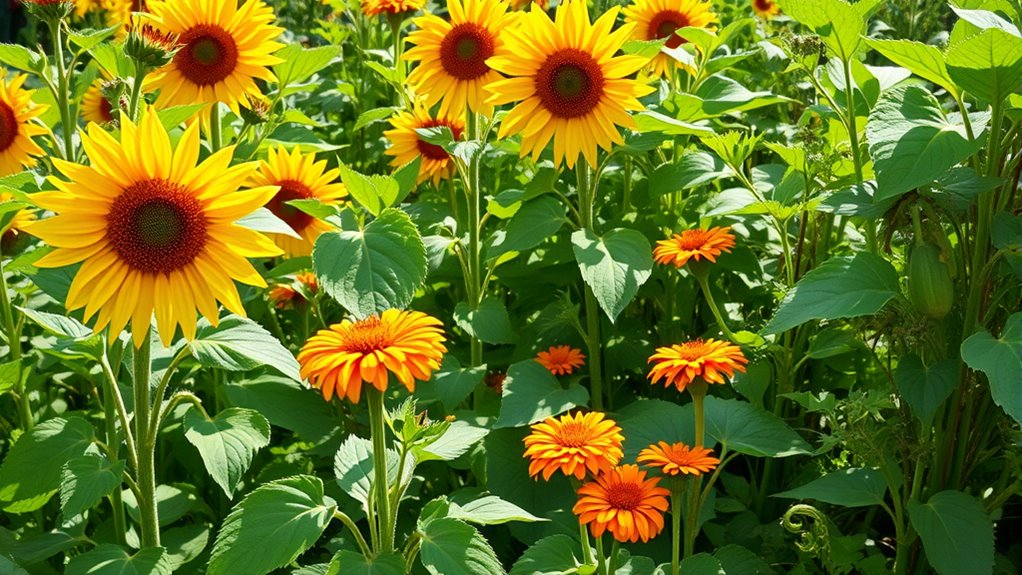
Sunflowers thrive when planted alongside certain companion plants that can enhance their growth and protect them from pests. Marigolds are a great choice because their strong scent deters aphids and beetles that might target your sunflowers. Basil is another excellent companion, as it can repel harmful insects and improve overall plant health. Cucumbers and beans also pair well, as they don’t compete for nutrients and can help improve soil conditions. Nasturtiums are beneficial too, acting as trap crops for pests like aphids and whiteflies. When selecting plants to grow near your sunflowers, focus on those that can either repel pests or improve soil quality. Proper companion choices can lead to healthier, more vibrant sunflowers with less need for chemical interventions. Companion planting can also promote biodiversity and attract beneficial insects that naturally control pests, further supporting your sunflower garden’s health.
Benefits of Companion Planting With Sunflowers
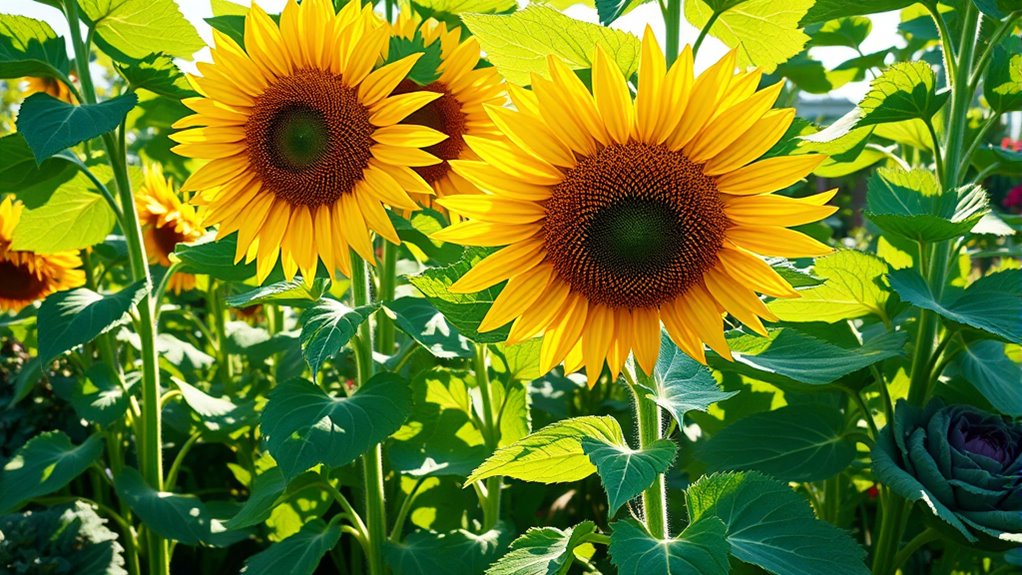
Companion planting with sunflowers offers numerous benefits that can enhance your garden’s health and productivity. Sunflowers attract pollinators like bees and butterflies, helping nearby plants thrive through better pollination. Their tall stature provides natural shade, protecting heat-sensitive plants from intense sun. Sunflowers also act as natural pest repellents, deterring insects that might damage other crops. Their deep roots improve soil structure and bring nutrients closer to the surface, benefiting surrounding plants. Additionally, sunflowers can serve as a windbreak, reducing damage from strong gusts. Growing sunflowers alongside vegetables or herbs can create a more balanced ecosystem, encouraging healthy growth and reducing the need for chemical interventions. Their self-cleaning capabilities help maintain overall garden hygiene and reduce disease spread. Furthermore, sunflowers can improve soil fertility by bringing nutrients up from deeper layers, benefitting the entire garden environment. They also contribute to the biodiversity of the garden by attracting a variety of beneficial insects and wildlife, promoting a resilient garden ecosystem. Incorporating sunflowers can also support soil health, leading to better crop yields over time. In addition, their ability to prevent soil erosion makes them an excellent choice for stabilizing garden soil on slopes. Overall, integrating sunflowers into your garden promotes a more resilient, vibrant, and productive space.
Plants to Avoid Growing Alongside Sunflowers

Some plants can actually hinder your sunflowers or compete for nutrients. Avoid growing tall, aggressive plants like fennel or pole beans nearby, as they may overshadow or compete with sunflowers. Being mindful of root competition helps make certain your sunflowers grow strong and healthy. Additionally, emerging technologies such as smart gardening tools could assist in monitoring soil health and plant interactions to optimize growth conditions.
Plants That Hinder Sunflowers
While planting sunflowers can be rewarding, certain plants can hinder their growth or cause problems. Avoid planting these species nearby to guarantee healthy sunflower development.
- Potatoes – They can attract pests like the Colorado potato beetle, which may spread to sunflowers.
- Fennel – Known to suppress the growth of many garden plants, fennel can stunt sunflower development.
- Corn – Competes for nutrients and water, which can limit sunflower growth and reduce yields.
- Tomatoes – They may increase the risk of pests and diseases that can affect both plants.
- Other plants – Certain species may compete for resources and hinder sunflower growth if planted too closely.
Sticking to compatible plants helps sunflowers thrive. Stay clear of these to prevent growth issues and guarantee a successful garden.
Root Competition Risks
Root competition poses a significant risk when planting certain species near sunflowers, as aggressive roots can deplete essential nutrients and water before your sunflower plants have a chance to thrive. Plants with extensive or invasive root systems, such as mint, horseradish, or fennel, tend to spread rapidly and compete fiercely for resources. These aggressive roots can stunt sunflower growth or cause them to weaken, especially in crowded or limited soil conditions. To give your sunflowers the best start, avoid planting species known for invasive roots close by. Instead, choose companions with shallow or non-invasive root systems that won’t overshadow or deplete soil nutrients. Being aware of invasive root behaviors can help you select the best companion plants and prevent competition issues. Understanding root system types can also guide you in choosing plants that coexist harmoniously. Recognizing plant root interactions can further improve your planting success and promote healthy growth. Keeping this in mind helps ensure your sunflowers grow healthy, tall, and vibrant.
Tips for Designing a Sunflower-Friendly Garden

Designing a sunflower-friendly garden starts with selecting the right location. Choose a spot that receives full sun for at least six hours daily, as sunflowers thrive in bright light. Make sure good air circulation to prevent disease and avoid wind damage. Prepare the soil by loosening it and adding compost to promote healthy growth. Space your sunflowers properly, giving each plant enough room to grow tall without crowding.
Choose a sunny, well-drained spot with good air circulation and proper spacing for healthy sunflowers.
Here are some tips to think about:
- Pick a sunny, well-drained site.
- Avoid low-lying areas prone to flooding.
- Use sturdy stakes for tall varieties.
- Plan for companion plants that won’t compete for nutrients or shade.
How Sunflowers Support Pest Control and Pollination
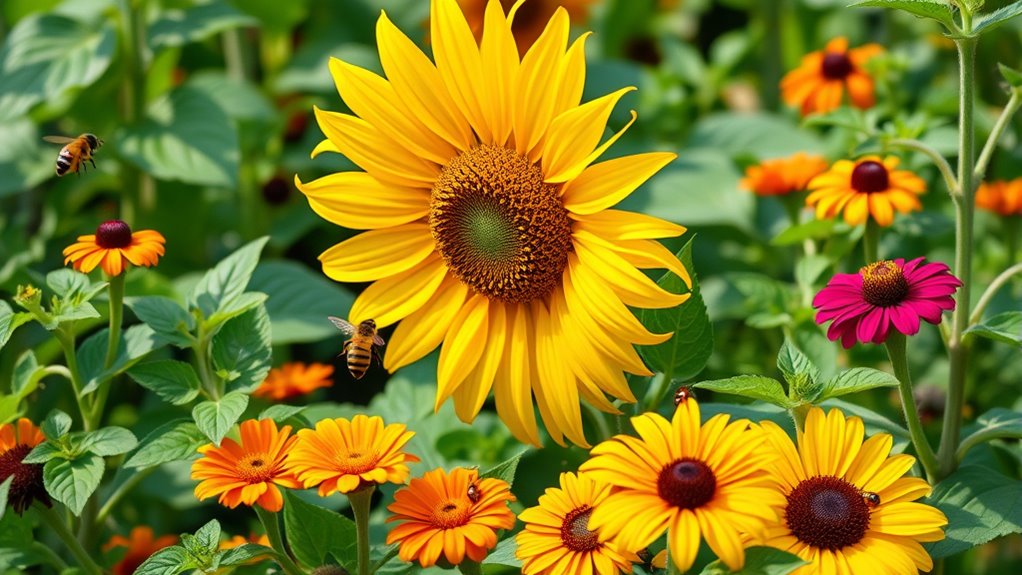
Sunflowers can help your garden by attracting beneficial insects that prey on pests, reducing the need for chemicals. They also improve pollination for nearby crops by drawing in bees and other pollinators. Understanding how sunflowers support these processes can boost your garden’s health and productivity. Additionally, sunflowers produce chemically active compounds that can influence the surrounding ecosystem and support natural pest control strategies. These compounds may also facilitate dynamic communication exercises, which further enhance garden health by promoting harmony among beneficial insects and plants. Recognizing the influence of utilitarian thinkers on ecological practices can inspire more sustainable gardening methods that prioritize the well-being of the entire ecosystem. Moreover, research into plant signaling shows how sunflowers can actively communicate with other plants, fostering a resilient and cooperative garden environment. Exploring how headphones can optimize outdoor listening experiences highlights the importance of understanding device features and environmental factors in maintaining effective use and ecosystem balance.
Attracting Beneficial Insects
Because of their large, vibrant blooms, sunflowers naturally attract beneficial insects like pollinators and pest predators to your garden. These insects help improve plant health and reduce pest populations without chemicals. To maximize this benefit, consider these tips:
- Plant sunflowers near vegetables and herbs to lure pest predators like ladybugs and lacewings.
- Leave some blooms uncut to provide continuous nectar sources for pollinators.
- Grow sunflowers in clusters to create a habitat that draws in more beneficial insects.
- Avoid using broad-spectrum pesticides, which can harm helpful insects and disrupt natural pest control.
Enhancing Crop Pollination
Did you know that planting sunflowers can substantially boost the pollination and pest control of your crops? Sunflowers attract a wide variety of pollinators like bees and butterflies, which transfer pollen between plants, increasing fruit and seed production. Their bright, large blooms act as visual lures, drawing insects away from your main crops and encouraging beneficial insects to visit. Additionally, sunflowers attract predatory insects such as ladybugs and parasitic wasps that help control pests naturally. By planting sunflowers nearby, you create a vibrant ecosystem that promotes healthy pollination and pest management without chemicals. The presence of core personality traits like predatory wasps further enhances the natural pest control process. This synergy not only improves crop yields but also promotes biodiversity and overall garden health, making sunflowers an invaluable companion for your gardening success. Furthermore, sunflowers can serve as a source of natural habitat for beneficial insects, supporting a balanced and resilient garden ecosystem.
Seasonal Considerations for Sunflower Companions

Understanding the seasonal needs of your sunflower companions is crucial for maximizing their growth and health. Different plants thrive at various times of the year, so timing is key. To guarantee success, consider these factors:
Maximize sunflower health by understanding and matching seasonal needs of companion plants throughout the year.
- Planting Time: Some companions, like beans, do best in early spring, while others, like cosmos, bloom later in summer.
- Temperature Tolerance: Choose plants that tolerate your area’s seasonal temperatures to prevent frost damage or heat stress.
- Water Requirements: Adjust watering based on seasonal rainfall and temperature changes to keep plants healthy.
- Growing Duration: Select companions that match sunflower growth cycles to ensure they mature together and support each other effectively.
Frequently Asked Questions
Can Sunflowers Be Grown Successfully Indoors With Companion Plants?
You can grow sunflowers indoors with companion plants, but you’ll need to provide plenty of sunlight or grow lights since sunflowers thrive in full sun. Choose companions like herbs or leafy greens that don’t compete for space or light. Make sure your containers are large enough for sunflower roots to spread. With proper care, your indoor sunflower and its companions can flourish, adding beauty and diversity to your space.
How Do Companion Plants Affect Sunflower Growth Rates?
Imagine your sunflowers reaching toward the sun, their growth influenced by nearby plants. Companion plants can speed up or slow down their growth, depending on what you choose. Some, like legumes, fix nitrogen, giving your sunflowers extra nutrients. Others may compete for water or space. By selecting the right companions, you can promote healthier, faster-growing sunflowers, creating a vibrant, thriving garden that benefits everyone involved.
Are There Specific Soil Types Best Suited for Sunflower Companions?
You should choose soil that’s well-draining, rich in organic matter, and slightly acidic to neutral for your sunflower companions. Loamy soil works best because it retains moisture without becoming waterlogged, supporting healthy root development. Avoid overly sandy or heavy clay soils, as they can hinder growth. Improving your soil with compost or aged manure boosts nutrients, helping both sunflowers and their companions thrive together.
Do Companion Plants Influence Sunflower Flowering Times?
They say, “A rising tide lifts all boats,” and the same applies to your garden. Companion plants can influence sunflower flowering times by either speeding up or delaying blooming, depending on their interactions. Some plants emit chemicals or compete for nutrients, affecting growth schedules. You should observe how your sunflowers respond to different companions and adjust planting times accordingly to guarantee a vibrant, synchronized display.
Can Companion Planting Extend the Blooming Season of Sunflowers?
You can influence your sunflower’s blooming season through companion planting. By choosing plants that improve soil health, attract pollinators, or provide some shade, you create a more supportive environment. For example, planting legumes nearby can enrich the soil, encouraging healthier, longer blooms. Additionally, attracting bees and butterflies helps with pollination, possibly extending flowering. While it may not drastically lengthen the season, strategic companions definitely promote healthier, more vibrant sunflower blooms.
Conclusion
So, now you’re armed with the secret society of sunflower sidekicks and enemies. Just remember, planting beans won’t turn your garden into a sunflower paradise overnight, and avoid the troublemakers like mint and fennel. With a little planning, your garden will be buzzing with pollinators and pest-free marvels. Who knew that sunflower companionship could be so strategic? So go ahead, get planting—and maybe, just maybe, leave some room for those sunflowers to strut their stuff!
